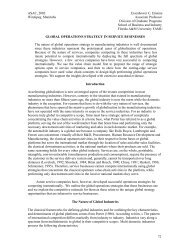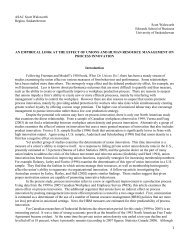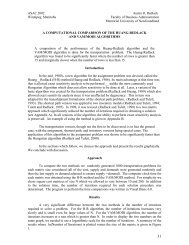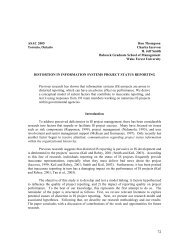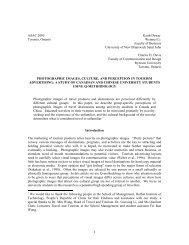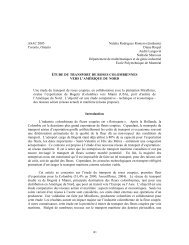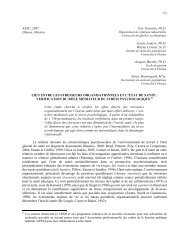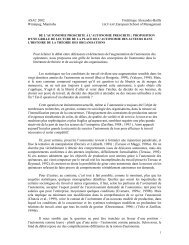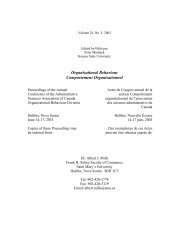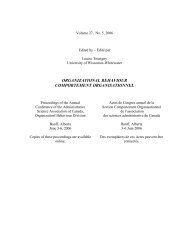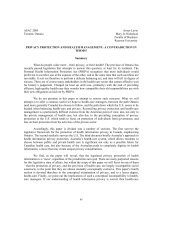ASAC-IFSAM 2000 Conference
ASAC-IFSAM 2000 Conference
ASAC-IFSAM 2000 Conference
You also want an ePaper? Increase the reach of your titles
YUMPU automatically turns print PDFs into web optimized ePapers that Google loves.
such developments in their respective organizations. As a result each organization was grapplingwith a number of change initiatives.The various changes the two organizations strove to introduce included an emphasis onteam-work, quality, and diversity. All three concepts required a shift for the companies to adifferent style of operating. Each of the change initiatives questioned and challenged existingorganizational values, norms, beliefs, behaviours, reward systems and the general modus operandiof the each company. In addition to changed actions and behaviours, different constructions ofmeaning and sensemaking (Weick, 1995) were required by organizational members for them to beable to respond to the changes. We were interested in conflicting and converging views of thechanges, the overt and covert resistance to change and the perceived success of the outcomes byorganizational members. The two case study organizations and the particular change initiatives eachwas hoping to implement will now be briefly explored.TechnicaTechnica is an internationally recognised company that develops and manufacturesadvanced technology. It is a company in which the sales people are well rewarded compared to thetechnical people even though it is the latter group who actually provide the ongoing support andservice that generates a large amount of revenue. During the course of the field study, Technicaattempted to implement a number of wide-ranging change initiatives. The U.S. Head Office ofTechnica developed a set of five values known as “Our Common Bond.” All Technica staff worldwidewere expected to embrace the five values associated with this common bond as the guidingprinciples for working at Technica and interacting with staff and customers. The values were:Respect for individuals; Dedication to helping customers; Highest standards of integrity;Innovation; and Teamwork.Valuing Diversity. The first value, Respect for the Individual, was Technica’s way oftrying to manage and value diversity. Diversity issues are particularly relevant in organizations oftoday. New Zealand, like other Western countries, is becoming an increasingly multicultural societyand workforce (e.g. Humphries & Grice, 1995; Pringle & Scowcroft, 1996).The value Respect for the Individual was Technica’s strategy for addressing diversity issues in theworkplace. The corresponding description for this value was:We treat each other with respect and dignity, valuing individual and culturaldifferences. We communicate frequently and with candor, listening to each otherregardless of level or position.It is interesting to note that while many Technica members stated that Our Common Bond valueswere positive in general and that respecting individuals was important, many participants felt thatthe value had little impact on the actual behaviour of Technica members, especially those in seniorpositions. In fact, Technica staff suggested that the values gave those in management an additionaltool from which to control and sanction the behaviour of staff (Casey, 1995). Indeed, despite thefocus on respecting differences, the values actually provided a mechanism for managers toencourage assimilation.“The Common Bond has had no impact and so therefore the training was a waste ofvaluable time. It was a reaction to a couple of harassment problems in the US andthe “feel good” approach to business at Head Office [USA]. But people here in theNew Zealand office, especially in management positions, make ad hocinterpretations of the values and use it to justify their own cause or excuse poorbehaviour.”<strong>ASAC</strong>-<strong>IFSAM</strong> <strong>2000</strong> Proceedings 4
While the rationale for adopting a team approach appeared sound, there was an inherentdilemma with this new approach. In the past individual competition had achieved the results thatComCo needed to meet its obligations to its Head Office. It ensured that the general managerachieved his personal bonus as did other members of staff. So in spite of the pep talks given to staffby the general manager about the need for teams and that the fact that people were organised intoteams with corresponding meetings, in reality little actually changed in the way people operated.“The culture is such that we are all competitive with each other and there is acertain amount of protectionism, people withhold information … We are supposedto be working more in teams now but we are almost all paid on commission, and socompetition naturally occurs.”Quality. Quality has been a popular catchword of the 1980s and 1990s (e.g. Costin, 1994;Deming, 1986; Juran, 1988; Teare, 1997). Quality was sold to ComCo, not only as a source ofcompetitive advantage, but as a ticket for survival in a marketplace of increasing competition andconsumer choice. Furthermore, ISO 9000 was a necessary pre-requisite for doing business withsome government departments. ComCo had attempted to gain ISO 9000 certification on at least twoother occasions. The most recent consultant contracted for the job suggested that instead of justfocusing on ISO 9000, ComCo should adopt a total quality management (TQM) philosophy. TQM(Total Quality Management) was sold as something that would result in major improvements to theoverall functioning of the company and enable it to make continuous improvements.To achieve ISO 9000 certification, documentation of processes and standard operatingprocedures is required. An accrediting agent then compares the specifications of the quality processand the quality outcomes against industry standards. Like the idea of teams, many ComCo membersacknowledged the considerable benefits that could arise from pursuing a quality initiative. Therewas, however, a definite lack of commitment as participation, sharing information and documentingprocesses had not been encouraged nor were they given a sufficiently high enough priority forpeople to afford the time or energy required for the process to proceed.“We never make the time to work together to talk about procedures and systems.Because of the way ComCo has always operated, we have nothing written down asthe GM has always made all the decisions. Plus there is always pressure to do ourjob and that is sell, sell, sell. Everything else is always secondary to that.”While there were difficulties implementing the specific team and quality change initiatives,there was widespread support amongst staff and managers alike that ComCo needed to change. LikeTechnica, there was an agreed need within both companies that changes were necessary if theywanted to continue to be competitive and significant players in their niche technological markets.The interesting question then, is why were the changes resisted?Success and Resistance to the Change InitiativesThe diversity, team, and quality initiatives at both Technica and ComCo were attempts totransform the way that these two companies functioned in response to a changing environment. Yetnone of the initiatives were implemented with much success at either company. There was strongresistance to the changes, even when organizational members appeared to sincerely agree with theneed or potential benefits associated with the rationale and specific change strategies.From the research findings and the brief discussion offered above, it is evident that none ofthe change initiatives at either Technica or ComCo met anything close to their potential. Whilethere are many possible reasons which could explain, at least in part, why each of the changeinitiatives failed, a gendered analysis will be developed as an alternative and informative<strong>ASAC</strong>-<strong>IFSAM</strong> <strong>2000</strong> Proceedings 6
that process issues as well as task achievement were given attention. Finally, diversity needed to bevalued in the increasingly heterogeneous organizational and customer world. Each of the changesrepresents a shift in the thinking and behaviour and all of the changes challenged the historical anddominant power structures of both organizations.Table 1 below highlights the characteristics that contribute to the success of the particularchange initiatives attempted in the two case study organisations as well as the characteristics whichdominated the organizations at the time of the research. The middle column captures some of thecommon themes alluded to in the literature which underpin the change initiatives while the thirdcolumn notes some of the contrasting characteristics that were encouraged, valued and rewarded atTechnica and ComCo.Table 1. The Gendered Nature of Organizational ChangeChangestrategyQualityTeamsDiversityCharacteristics of changesEncourages participation & facilitatesinclusion, shares power & information,energises & excites others about work &changes, quality of work life.Collaboration, co-operation,interdependence, concerned about welfare ofothers, not solely motivated by self-interest.Concern about the welfare of others,supportive, receptive, empathetic.Orientation toward power as a transforming& liberating force to be used for publicpurposes rather than for personal ambitionand power over others.FEMININECHARACTERISTICSExisting characteristicsTask focus, quantity focus,achievement-oriented (sales),competition & conflict, awin/lose approach to conflictresolution.Independent, competitive,individual recognition &advancement, self-reliant,Individual recognition &advancement (of behavioursthat fit the status quo),hierarchical structure,forcefulness, status-conscious.MASCULINECHARACTERISTICSAn analysis of the characteristics in the middle column suggests an overlap with femininecharacteristics described previously whereas the characteristics in the third column are congruentwith frequently described masculine characteristics (Fondas, 1997; Marshall, 1984). Hence, wehave labelled the characteristics in the middle column, those associated with the new cultures or thedesired characteristics underlying the change initiatives as ‘feminine’ and the characteristicsassociated with the existing organizational cultures as ‘masculine.’Considering the underlying characteristics of the change initiatives as feminine attributesmight help us understand why the changes were resisted so strongly and therefore failed. Byresisting these changes, the dominant masculine culture continued to be perpetuated whichpromoted and encouraged individualism, competition, task focus and a patriarchal and narrowdefinition of competence and achievement. We suggest that labelling the characteristics of theexisting dominant cultures of ComCo and Technica ‘masculine’ and the new cultures that thechange initiatives necessitated ‘feminine’, offers a gendered lens for exploring culture and change.Such an approach contributes to our understanding of why there was such resistance to the changeinitiatives in both organizations.<strong>ASAC</strong>-<strong>IFSAM</strong> <strong>2000</strong> Proceedings 8
As Morgan (1997) notes, the links between the masculine stereotype and the values thatdominate many ideas about the nature of organizations are striking. Organizations are oftenencouraged to be rational, analytic, strategic, decision-oriented, tough, aggressive, As noted earlier,ideas about masculinity and femininity are embedded in organizational arrangements anddifferentially valued (Fondas, 1997). We do not want to suggest that there was a consciouscategorization of the changes as feminine and therefore imply that the resistance was overt andexplicitly aimed at squashing the feminization of the workplace. People in both companies, at alllevels of the hierarchy, had devised strategies for subverting, ignoring or undermining the changeinitiatives. Feminine characteristics were implicitly embedded in the change initiatives,characteristics that are devalued by society. The resistance served to maintain the status quo andvalue ascribed to masculine characteristics.DiscussionAs long as we continue to treat organizations as gender neutral then we are ignoring andsustaining the patriarchal foundation upon which modern organizations are based. One way tochallenge these premises is to continue to point to the masculinist bias apparent in mostorganizations. What is needed is call into question not what has been socially constructed asfeminine but why these characteristics are ascribed less value and status.Woodward (1996) extended Hofstede’s (1988) national cultural dimension of masculineand feminine to organizations. Masculine, according to this conceptualization, bestows importanceon financial rewards, recognition and challenge whereas the feminine pole values the importance ofrelationships, co-operation, and security of employment. The meanings of the labels of masculinityand femininity have been contentious which have led to interesting modifications. Robbins et al.(1998), an influential writer of management education texts, has relabelled masculinity andfemininity to ‘quantity’ and ‘quality’. In a further adaptation Adler (1998) relabelled Hofstede’sdimensions as ‘career success’ and ‘quality of life.’This re-framing of the masculinity and femininity serves two obvious purposes: It furtherrefines the meanings of the concepts but also highlights the discomfort felt when using concepts ofmasculinity and in particular, femininity. Feminist theorists have underscored the differential valueascribed to feminine characteristics. “There is nothing the matter with difference; the problem isthat one of the two categories … is devalued” (Martin, 1994:8). As evident from the currentresearch findings, this devaluation has significant implications. Masculinity and femininity areassociated with differential status in society that is also apparent in organizational settings.Stereotypical feminine characteristics such as co-operation, empathy, an emphasis on relationshipsand connection are not valued, beyond the rhetorical, in companies such as Technica and ComCobecause of cultures and practices which reinforce competition, individual sales prowess and ‘gettingan edge’ over competitors. So while there may be a desired shift toward incorporating femininecharacteristics there is also a competing resistance that works to maintain the masculine status quo.It is not helpful to elevate the status of one set of characteristics (e.g. feminine) over theother. However, by invoking the terms masculine and feminine and overtly describing theresistance to the feminization of cultures and change initiatives we are highlighting an alternativelens for considering why organizations are struggling to implement critical changes necessary totheir continued success. Furthermore, we are contributing to the growing literature offering agendered perspective to organisational theorizing (e.g. Fletcher, 1994; Smircich, 1985).We acknowledge that restricting our thinking to a dichotomous, oppositional, binarystructure, as Scott (1988) points out, creates an either/or choice. We are not suggesting ‘feminine’<strong>ASAC</strong>-<strong>IFSAM</strong> <strong>2000</strong> Proceedings 9
characteristics and qualities be appropriated or exploited for competitive advantage in organizationsthat are still essentially patriarchal (Calas & Smircich, 1993). Furthermore, we do not wish to implythat the consultants and change agents in the two case organizations deliberately wanted tointroduce feminine characteristics. Instead we propose the recent change trends are a response orreaction to a set of characteristics that are no longer appropriate or working in a changingorganizational world. Acknowledging and naming the resistance to the feminization that is takingplace in organizations, allows managers, practitioners and academics to better understand whymasculinist cultures continue to dominate and prevail.Smircich (1985:67) called for the addition of a feminist voice to the cultural research. Wesuggest that the gender analysis of change initiatives offered here goes some way to fulfilling thisaim. We concur with Martin (1990: 357) that “if feminist perspectives were fully incorporated[within organizational analysis], the usual emphases on rationality, hierarchy, competition,efficiency, and productivity would be exposed as only a very small piece of the organizationalpuzzle.” In this paper we have offered an alternative explanation for understanding cultures andchange initiatives based on a gendered analysis of the dominant culture at both Technica andComCo and the underlying characteristics of the change initiatives.We have suggested that an implicit reason for the resistance and ultimately failure of thechange initiatives in the two case organizations were due to the gendered nature of the attemptedchanges. Specifically the underlying and unnamed feminization of the changes and the lack ofawareness of the lesser valued ascribed to the feminine caused the changes not to take hold inpredominantly masculine organizational cultures. Like other writers, we believe that raising theawareness of this feminization/gendered process assists us in understanding organizations asgendered entities. As demonstrated in this paper, such an analysis offers theoretical and practicalinsights into the failure of the change initiatives in the case study organizations – insights thatwould not be gleaned from much of the extant organizational change literature.ReferencesAcker, Joan., Hierarchies, jobs, bodies: A theory of gendered organizations. Gender & Society 4,139-158, 1990.Acker, Joan., Gendering organizational theory. In A. Mills & P. Tancred (eds.) Genderingorganizational analysis, (pp. 248-260). Newbury Park: Sage, 1992.Adler, Nancy. International dimensions of organizational behaviour. (2nd ed). Boston: Kent, 1998..Alvesson, Mats. & Due Billing, Yvonne. Understanding gender and organizations, London: SagePublications, 1997.Alvesson, Mats. & Berg, Per Olof. Corporate culture and symbolism: An overview. Berlin: Walterde Gruyter, 1992.Belbin, Meredith. Team roles at work.. Oxford: Butterworth-Heinemann, 1993.Brown, Andrew. Organizational culture. London: Pitman, 1995.Burrell, Gibson. & Morgan, Gareth. Sociological paradigms and organizational analysis. London:Heinemann, 1979.<strong>ASAC</strong>-<strong>IFSAM</strong> <strong>2000</strong> Proceedings 10
Calas, Marta. & Smircich, Linda. Dangerous liaisons: The “feminine-in-management” meetsglobalization. Business Horizons, March/April, 71-81, 1993.Calas, Marta & Smircich, Linda “From the ‘Women’s’ Point of View: Feminist Approaches toOrganization Studies” In Stewart Clegg, Cynthia Hardy and Walter Nord (eds.), Handbookof Organization Studies. (pp 218-257), London: Sage. 1996,Casey, Catherine , Work, self and society: After industrialism. London: Routledge, 1995.Collinson, David and Hearn, Jeff, Men as managers, managers as men: Critical perspectives onmen, masculinities, and management, London: Sage, 1996.Costin, Harry. Quality: Readings in total quality management. Fortworth: Dryden Press, 1994.Cox, Taylor. Cultural diversity in organizations: Theory, research and practice. San Fransisco:Berrett-Koehler, 1993.Cummings, Thomas. & House, Edgar. Organization development and change. San Francisco: WestPublishing, 1989.Daft, Richard. & Steers, Richard, Organizations: A micro/macro approach. Glenview: Foresman,1986.Delphy, Christine. Rethinking sex and gender. Women Studies International Forum, 16(1), 1-9, 1993.Deming, William. Out of the crisis. Cambridge: MIT Centre for Advanced Engineering, 1986.Duck, Jeanie. Managing change: The art of balancing. Harvard Business Review, 71(6):109-118,1993.Ellis, C. & Sonnenfeld, J. Diverse approaches to managing diversity. Human ResourceManagement, 33(1): 70-109, 1994.Ferguson, Kathy. The feminist case against bureaucracy. Philadelphia: Temple University Press,1984.Fletcher, Joyce. Castrating the female advantage: Feminist standpoint research and managementscience. Journal of Management Inquiry, 3(1): 74-82, 1994Fondas, Nanette. Feminization unveiled: Management qualities in contemporary writings. Academyof Management Review, 22(1), 257-282, 1997.French, Wendel, Bell, Cecil, & Zawacki, Robert., (eds.) Organization development andtransformation: Managing effective change. Illinois: Irwin, 1994.Geertz, Clifford. The interpretation of cultures. New York: Basic Books, 1973.Gilligan, Carol. In a different voice: psychological theory and women's development, Cambridge:Harvard University Press, 1982.Green, Eileen & Cassell, Catherine. Women managers, gender cultural processes and organizationalchange, Gender, Work, and Organization, 3(3), 168-178, 1996.<strong>ASAC</strong>-<strong>IFSAM</strong> <strong>2000</strong> Proceedings 11
Guzzo, Richard & Salas, Eduardo., Team effectiveness and decision making in organizations. SanFrancisco: Jossey-Bass, 1995.Harlow, E. & Hearn, Jeff. Cultural constructions: Contrasting theories of organizational culture andgender construction. Gender, work, and organization, 2(4), 180-191, 1995.Harris, Lloyd & Ogbanna, Emmanuel. Employee responses to culture change efforts. HumanResource Management Journal, 8, 78-92, 1998.Hearn, Jeff & Collinson, David. Naming men as men: Implications for work, organization andmanagement. Gender, Work and Organization, 1,(1), 2-22. 1995.Henley, Nancy & LaFrance Marianne Gender as culture: Difference and dominance in nonverbalbehavior. In A. Wolfgang (ed.) Non-Verbal Behavior. (pp 351-371), Hogstede Press. 1984.Hofstede, Geertz. Culture’s consequences: International differences in work-related values.Beverley Hills: Sage 1988.Humphries, Maria & Grice, Shayne. Equal employment and the management of diversity. In PeterBoxall (ed), The challenge of human resource management: Directions and debates in NewZealand. Auckland: Longman Paul, 1995.Juran, Joseph., Juran on planning for quality. New York: Free Press, 1988.Lincoln, Yvonna & Guba, Egan., Naturalistic inquiry. Newbury Park: Sage, 1985Loden, Marilyn & Rosener, Judy. Workforce America!: Managing employee diversity as a vitalresource.. Illinois: Business One, 1991Marshall Judi. Women Managers: Travellers in a male world. Chichester: John Wiley & Sons,1984.Martin Joanne. Deconstructing organizational taboos: The suppression of gender conflict inorganizations. Organization Science, 4: 339-359, 1990.Martin Joanne. The organization of exclusion: Institutionalization of sex inequality, genderedfaculty jobs and gendered knowledge in organizational theory research. Organization, 1(2):401-431, 1994.Meek, Lynn. Organizational culture: Origins and weaknesses. Organization Studies, 9(4): 453-473,1988.Miles, Matthew. Qualitative data as an attractive nuisance: The problem of analysis, AdministrativeScience Quarterly, 24, 590-601, 1979.Mills, Albert. Organization, gender and culture. Organization Studies, 9(3): 351-370, 1988.Morgan, Gareth. Images of organizations. London: Sage, 1997.Parker, Glenn. Team players and team work: The new competitive business. San Francisco: Jossey-Bass, 1996.<strong>ASAC</strong>-<strong>IFSAM</strong> <strong>2000</strong> Proceedings 12
Pringle, Judith & Scowcroft, Jenny, Managing diversity: Meaning and practice in New Zealandorganisations. Asia Pacific Journal of Human Resources, 34(2): 28-43, 1996.Robbins, Stephen., Waters-Marsh, Terry, Cacioppe, R., & Millett, Bruce. Organisational behaviour:Concepts, controversies and applications. (Australia and New Zealand edition). EnglewoodCliffs: Prentice Hall, 1998.Scott, Joan. Deconstructing equality-versus-difference: or, the uses of poststructuralist theory forfeminism. Feminist Studies, 14(1), 33-50, 1988.Smircich, Linda. Is the concept of corporate culture a paradigm for understanding organizations andourselves? In Frost, Peter, Moore, Louis F., Louis, M. R., Lundberg, C. C. & Martin, Joanne(eds). Organizational culture: The meaning of life in the workplace. (pp. 55-72), NewburyPark: Sage, 1985.Thomas, David & Ely, Robyn. Making difference matter: A new paradigm for managing diversity.Harvard Business Review, Sept-Oct., 79-90, 1996.Weick, Karl. Sensemaking in organizations. London: Sage, 1995.West, Candida. & Zimmerman, Don. Doing gender. In Judith Lorber & Susan Farrell (eds.) Thesocial construction of gender, (pp 13-37). Newbury Park: Sage, 1991.Woodward, Amanda, Multinational masculinities and European bureaucracies. In David Collinson& Jeff Hearn (eds.). Men as managers, managers as men: Critical perspectives on men,masculinities and management. (pp 167-185), London: Sage, 1996.<strong>ASAC</strong>-<strong>IFSAM</strong> <strong>2000</strong> Proceedings 13



